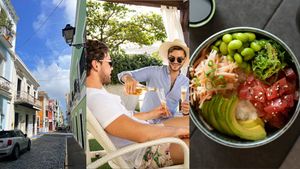In director Dee Rees's debut feature Pariah ( 2011 ), the central character, Alike, seeks to find herself, not only within the socially binding world she inhabits, but stylistically, too. Oscillating between two extremes (the pastel-colored, dainty blouses from her mother and the oversized shirts and fitted hats of a close friend), the young poet exists in a middle ground. When Kris Harrington saw the film, she identified deeply, all too familiar with this specific process of growing up in the space between familiar categories.
Related | Gallery: Kris Harrington Is Defining Modern, Androgynous Eveningwear
"I remember Easter very vividly; I would have to wear those really ugly dresses," says Harrington, Out's third annual Fashion Vanguard. "And then there were the socks with the little frill around them and the patent leather loafers. Meanwhile, my cousins, who were boys, got to wear their suits." Sitting in the Bed-Stuy studio for her gender-irreverent, semi-eponymous brand, Kris Harring, and miles away from her childhood home of Silver Springs, Maryland, Harrington continues, "That was the point where I was like, this is not for me."
And yet, at 16, when she was exposed to queer nightlife in Washington, D.C. she also found that the oversized, hoodie-wearing aesthetic of butch lesbians wasn't her style, either. The conundrum started a long-standing question for the Fashion Institute of Technology (FIT) alum: What does it look like to be androgynous or nonconforming in dress?
First, remedies came through styling and personal buying. After fashioning herself in a mix of menswear and womenswear while building a career on the sales and marketing side of magazines, Harrington began to receive messages from friends requesting her services. "A lot of androgynous people have the same questions: 'What am I supposed to wear? What does it look like? What do I wear to job interviews?' " She became the expert in her circle. And then a 2010 sewing class, overseen by a technical designer in Brooklyn, opened her eyes to a whole new world of possibilities.
"Before that [class], I didn't know about all of these different careers in fashion," she says. "I just knew stylist and designer for runway. I wasn't necessarily worried about high fashion, I just wanted to make clothing that spoke to me -- that translated something I thought was missing from the market."
In addition to that fateful sewing class, a two-year menswear program at FIT helped Harrington hone her aesthetic, while a Design Entrepreneurs Accelerator program allowed her to create and sharpen her business plan. She picked up lessons through a variety of internships and design positions.
At Ermenegildo Zegna, she learned about fabrics; at DKNY Jeans, she picked up womenswear design techniques like draping; and at PVH, designing for the heritage brand Van Heusen, she learned the business of designing while considering price point.
The collective results debuted in her brand, Kris Harring, which launched in 2017 and initially served to answer the question of what Harrington might wear to a wedding or any other formal setting. With its sheer silk organza palazzo pants and sleek, pared-down renderings of the classic tuxedo (no lapel, minimal buttons, slim silhouette), the line planted the designer's flag in the market. It was a fresh take, and a departure from the traditional suiting Harrington designed while making a name for herself, early on, with her customs business.
"I personally haven't worked with anyone who looks like me," she says, "who was a masculine [of center] designer. So this is not just about me making stuff. For me, it's a part of my activism -- part of me being able to contribute to a larger conversation. This is about me inspiring younger people who maybe didn't see themselves.
To check out Harrington's latest collection, click here.
Photography by Ricardo Nelson
Hair: Nate Juergensen
Makeup: Zac Hart
Shot on location at the Arlo Soho hotel in NYC


















































































